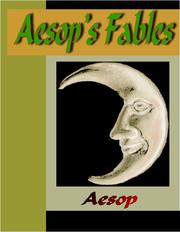Check nearby libraries
Buy this book

Throughout history fables have been a popular method of giving instruction. Fables contain a short narrative that seeks to illustrate a hidden message. Generally, fables use animals or objects as part of the narrative yet the message is designed to apply to humans. By doing this, the fabulist is not perceived as the teacher and this reduces any bias the listeners might have against the person. The most famous fabulist would be Aesop who most date around 620 B.C. Many fables are attributed to Aesop, but it's unclear how many he actually wrote; indeed, his historical existence as a person is under question. Here is a collection of over 300 of Aesop's classics.Please Note: This book is easy to read in true text, not scanned images that can sometimes be difficult to decipher. The Microsoft eBook has a contents page linked to the chapter headings for easy navigation. The Adobe eBook has bookmarks at chapter headings and is printable up to two full copies per year. Both versions are text searchable.
Check nearby libraries
Buy this book

Subjects
Fiction, Folklore, Juvenile Fiction, FablesShowing 1 featured edition. View all 1 editions?
| Edition | Availability |
|---|---|
| 1 |
aaaa
Libraries near you:
WorldCat
|
Book Details
Edition Notes
The Physical Object
ID Numbers
Community Reviews (0)
Feedback?| February 17, 2024 | Edited by ImportBot | import existing book |
| April 27, 2023 | Edited by OnFrATa | merge authors |
| July 22, 2019 | Edited by MARC Bot | remove fake subjects |
| June 30, 2010 | Created by ImportBot | new OverDrive book |









